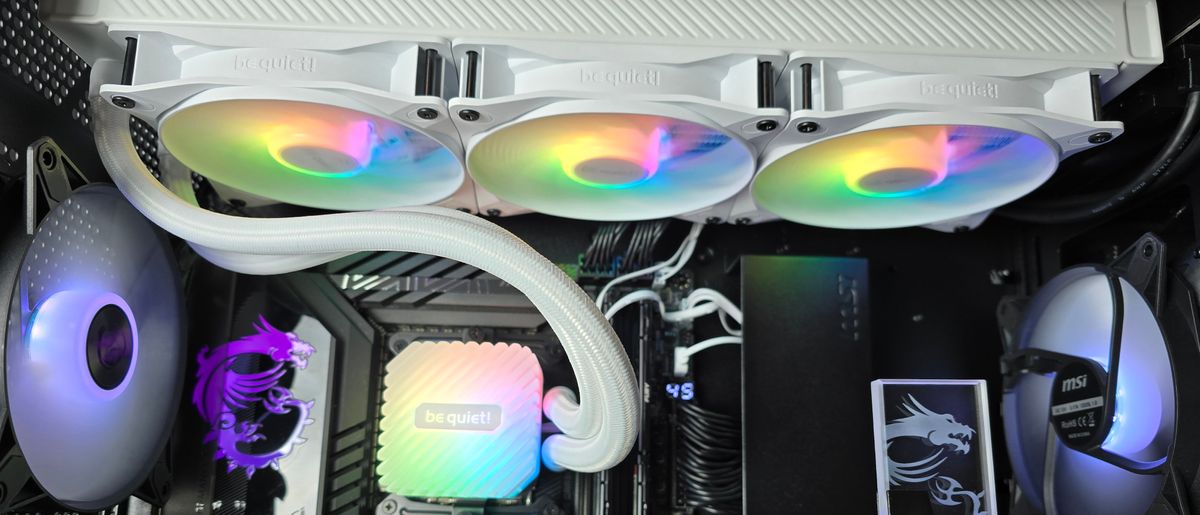Tom's Hardware Verdict
Be Quiet’s Light Loop 360 delivered industry-leading thermal performance and low noise levels in our testing, and it comes with some nice extras in the box.
Pros
- +
Industry-leading thermal performance
- +
Low noise levels in common workloads
- +
DIY-friendly, with extra liquid coolant
- +
ARGB and PWM hub included
Cons
- -
Installation could be simpler
Why you can trust Tom's Hardware
The brand Be Quiet! should be familiar to most enthusiasts, with their products focused on – as the name implies – cooling performance with low noise levels. The company’s cases have made several appearances on our Best PC Cases list, and its Silent Base 802 was the case I used for CPU Cooler reviews which used Intel’s i7-13700K.
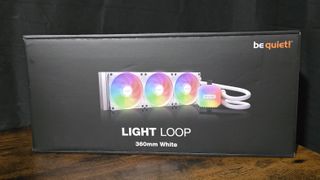
Today’s review, we’re looking at Be Quiet’s latest AIO – the Light Loop 360. It features a newly designed pump and cold plate and – spoiler alert – this cooler is definitely making our list of the best CPU coolers! Let’s take a quick look at the unit’s specifications, then we’ll dive into its features and the benchmarks.
Cooler specifications
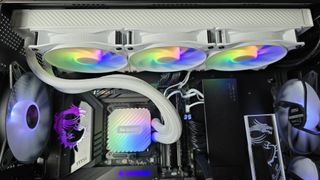
| Cooler | Be Quiet! Light Loop 360 |
| MSRP | $159.90 (U.S.) |
| Radiator Material | Aluminum/black painted |
| Pump Speed | 1500-2900RPM, featuring a new pump design |
| Lighting | ARGB on the fans, diffused lighting on CPU block |
| Warranty | 3 Years |
| Socket Compatibility | Intel Socket LGA 1851/1700/1200/115x AMD AM5 / AM4 |
| Unit Dimensions (including fans) | 397 (L) x 120 (W) x 52mm (D) |
| Base | Nickel-plated copper, with redesigned cold-plate |
| Maximum TDP (Our Testing) | >265W with Intel’s i7-14700K |
Packing and included contents
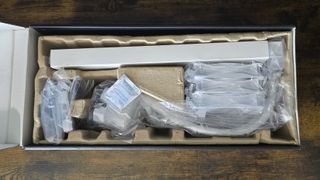
The packaging of the AIO is much like many others, with molded cardboard for primary packaging and both cardboard and plastic coverings for the individual parts.
Included with the box are the following:
- Three 120mm fans
- 360mm radiator and CPU block
- Hardware hub supporting PWM & ARGB connections
- Thermal paste
- Cable management ties
- Extra liquid coolant
- Mounting for modern AMD and Intel platforms
- Two Be Quiet logo stickers
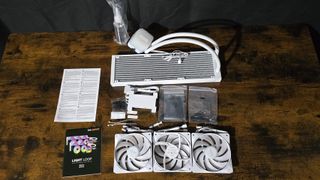
Features of Be Quiet’s Light Loop 360
▶️ DIY friendly, with extra liquid coolant
The Light Loop 360 includes an easily accessible refill port, should you need to refill the unit’s coolant after the warranty expires.
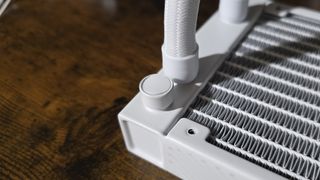
Usually, when it comes to AIOs, I go out of my way to recognize companies when they simply don’t include a consumer-unfriendly “warranty void if removed” sticker on top of the refill port – an action that’s technically illegal under the Magnuson-Moss Warranty Act in the USA.
Not only does Be Quiet refrain from trying to scare consumers away from servicing their own equipment, but the company also goes the extra mile and actually includes extra coolant for the AIO. This sort of consumer-friendly approach deserves special recognition.
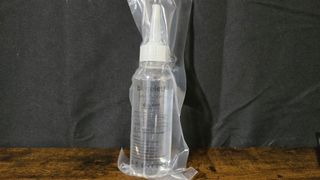
▶️ Redesigned liquid pump and CPU contact plate
The most exciting part of Be Quiet’s Light Loop 360 is the newly redesigned liquid pump and CPU contact plate. This enables the thermal performance that makes AIO stand out from the competition, as you’ll see shortly in our benchmarks.
I pressed Be Quiet to see if I could obtain any additional details about the improvements under the hood. This is what a company rep told me, with a few edits for clarity:
The Light Loop has a split flow design on its cold plate, which means the flow comes from left and right and is guided to the middle, while the liquid in the previous generation Pure Loop 2 block flows from left to right. This leads to a higher turbulence where the two streams "clash" in the middle.
On top of the split flow, the Jet Plate in the Light Loop block helps to guide the liquid through the fins, increasing cold plate efficiency. More movement in the liquid leads to better heat transfer, and therefore more efficient transmission of heat to the cooling liquid - especially on Intel CPUs where the hot spot is centered (or not as offset as on AMD, in the case of the Ultra series).
The Pure Loop 2 has more of an all-rounder approach in that regard and that is part of the reason why the Light Loop comes with an AMD offset mounting, as this solution is not as ideal for a lower hot spot.
The Light Loop's flow and especially pump pressure was increased with a larger impeller in the block, which allows for lower RPM, and the switch to a 6-Pole 3-Phase Motor design with a very progressive IC allows for quieter pump operation.
Lastly, the cold plate itself is thinner in the fin area than on the previous generation Pure Loop 2. Copper is good at conducting heat, but longer travel distances still decrease efficiency. Thinner is better for thermal transfer, but finding the right balance to achieve as thin as possible while not risking defects is not easy and requires tight tolerance machining.
▶️ 27mm Radiator
The Light Loop 360 includes a radiator that’s 27mm thick, which is standard for most liquid coolers.
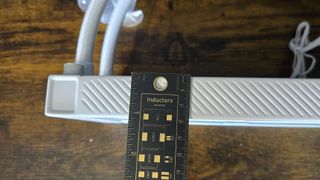
▶️ Hardware ARGB and PWM Hub
Instead of using daisy-chain connections, Be Quiet includes an ARGB and PWM fan hub in the box. It supports six fans, which will be useful for those who would like to purchase additional fans and configure the AIO in push-pull configuration for maximum thermal performance.
The hardware hub can be conveniently attached to a SSD plate supporting 2.5-inch drives, simplifying installation.
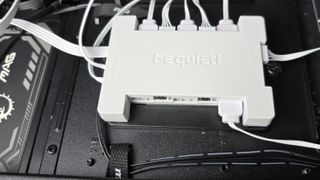
▶️ Thermal Paste
Be Quiet includes a small tube of thermal paste with the AIO, sufficient for approximately 3-4 installations. The company curiously does not list the SKU of thermal paste used, so we’re not sure if this is the DC2 thermal paste they offer or a newer paste not yet available separately.
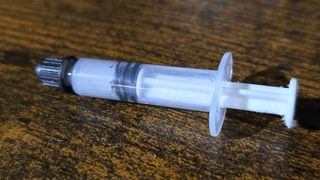
▶️ Cable ties and stickers
Be Quiet includes standard zip ties for cable management purposes, and also two stickers bearing its logo for those interested in that type of thing.

▶️ Light Wings LX 120mm PWM high-speed fans
There’s more to a cooler than just the heatsink or radiator. The bundled fans have a significant impact on cooling and noise levels, as well as how the cooler looks in your case. The fans included are Light Wings LX 120mm PWM high-speed – which, as the benchmarks will show, enable strong cooling performance both at full speed and when restricted to low noise levels!
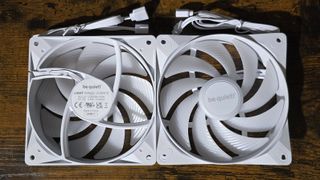
| Dimensions | 120 x 120 x 25mm |
| Fan Speed | Up to 2100 RPM |
| Air Flow | Up to 61.8 CFM |
| Air Pressure | Up to 2.51 mmH2O |
| Bearing Type | Rifle Bearings |
| Lighting | ARGB |
▶️ New CPU block design
The CPU block has a new aesthetic, with “fins” illuminated by diffused lighting.
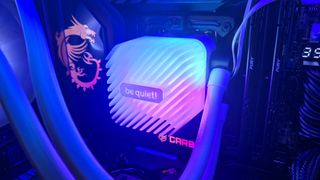
▶️ Fully rotatable tubing
The tubing of the AIO is fully rotatable, which can make installation a little simpler.
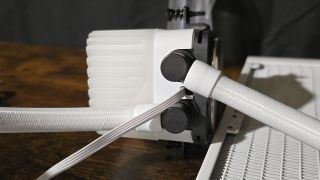
▶️ Full RAM Compatibility
Like almost every other AIO on the market, the Light Loop 360 doesn’t interfere with or overhang RAM DIMMs in any manner – allowing for the use of all sizes of RAM, no matter how tall.
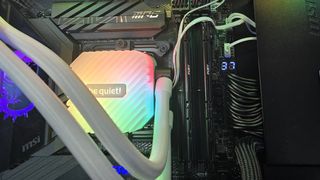
Testing configuration – Intel LGA1700 and LGA1851 platform
| CPU | Intel Core i7-14700K |
| GPU | ASRock Steel Legend Radeon 7900 GRE |
| Motherboard | MSI Z790 Project Zero |
| Case | MSI Pano 100L PZ Black |
| System Fans | Iceberg Thermal IceGale Silent |
There are many factors other than the CPU cooler that can influence your cooling performance, including the case you use and the fans installed in it. A system's motherboard can also influence this, especially if it suffers from bending, which results in poor cooler contact with the CPU.
To prevent bending from impacting our cooling results, we’ve installed Thermalright’s LGA 1700 contact frame into our testing rig. If your motherboard is affected by bending, your thermal results will be worse than those shown below. Not all motherboards are affected equally by this issue. I tested Raptor Lake CPUs in two motherboards. And while one of them showed significant thermal improvements after installing Thermalright’s LGA1700 contact frame, the other motherboard showed no difference in temperatures whatsoever! Check out our review of the contact frame for more information.
I’ve also tested this cooler with Intel’s latest platform, Arrow Lake and LGA 1851.
| CPU | Intel Core Ultra 9 285K |
| GPU | MSI Ventus 3X RTX 4070Ti Super |
| Motherboard | MSI Z890 Carbon Wifi |
| Case | MSI MPG Gungnir 300R |
| System fans | Pre-installed case fans |
LGA 1700 and 1851 Installation
The installation of the AIO is my only real complaint about this product, as it takes more steps and is slightly more difficult than with other coolers. For some, it may be simpler to first attach the fans to the radiator and secure the radiator to your case before moving to the following steps.
1. You’ll first need to place the backplate against the rear of the motherboard, and then secure it using the included standoffs. Before you place the backplate against the rear of the motherboard and secure it using the included standoffs (which is usually the first step), you’ll need to assemble the backplate as shown below.
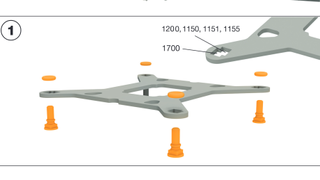
2. Next, you’ll secure the backplate by attaching standoffs. You’ll then place the mounting bars on top of the standoffs, and secure them with the included screws.
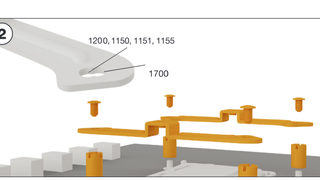
3. Apply the included thermal paste to your CPU. If you have any questions on how to do this properly, please refer to our handy how to apply thermal paste guide.
4. Place the CPU block on top of the CPU, and secure it with a screwdriver.
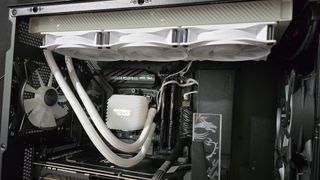
5. Install the hardware ARGB and PWM hub to a location of your choosing, connecting it to SATA power and your motherboard’s CPU PWM slot. Then connect the fans to the hardware hub.
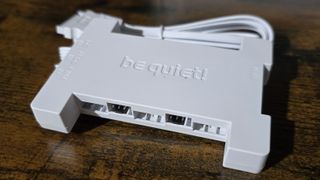
6. After all that, power on your computer and installation is complete!


Albert Thomas is a contributor for Tom’s Hardware, primarily covering CPU cooling reviews.

AMD chips now comprise 55 percent of Puget Systems orders — AMD makes big inroads in professional systems

Chinese hackers target US Treasury computers used for sanctions — Committee on Foreign Investment specifically targeted

Intel reveals Core Ultra Series 2 stock coolers with more conductive copper-base heatsinks
-
thestryker It's too bad they don't sell this one in a non-RGB puke form (or at least non-RGB fans) as this seems like a great cooler. The only light in inside my case is the EVGA logo on my video card and I'd like to keep it that way.Reply
One thing you could consider doing is checking the cold plates on the coolers to see if they have a bump to get extra performance. This is mostly academic without long term testing, but some of the cheaper models that's basically what they did. I think Asus also did it with at least one of the Ryujin coolers.
Looking forward to the new year for coolers though as hopefully the new Hyte AIOs will hit and Thermalright has listed the Royal Pretor 130 on their site so I'd assume retail availability will be soon.
I'm waiting until Intel publicly states yay/nay on more LGA 1851 parts before picking a new AIO. While I don't need it at all now I'll probably get a new video card at some point which won't have it's own AIO at which point I would. -
Albert.Thomas Reply
Now you're just making me hungryUnforcedERROR said:You just come home from the BBQ house, Albert? -
UnforcedERROR Reply
I had an intern for a while who typed "y'all" in all of her emails. I can't unsee it now.Albert.Thomas said:Now you're just making me hungry -
Albert.Thomas Reply
Y'all better get used to it ;)UnforcedERROR said:I had an intern for a while who typed "y'all" in all of her emails. I can't unsee it now.
